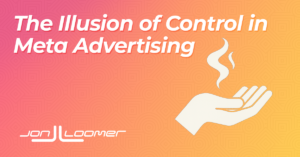
The bulk of complaints from Meta advertisers in 2025 center on the topic of control, or a lack of it. My biggest frustration is advertisers’ obsession with the fleeting illusion of control.
¿Te gustaría tener un "Empleado Digital" que trabaje por ti?
Este blog funciona en piloto automático gracias a la tecnología n8n. Aprende a montar tu propio imperio automatizado por menos de lo que cuesta una pizza.
🚀 Acceder al Curso (Oferta $10)🔒 Garantía de satisfacción de Hotmart
Stop advertising like it’s 2017. I miss those days, too, but we’re not going back. The tools have changed, as has your role in the process. Your refusal to evolve won’t stop where advertising is headed. Ignore this progression and you’ll be phased out.
There was a time when control of advertising was both possible and necessary. There was a benefit. But in many cases now, attempting to force this control is either unnecessary or impossible. Today, that benefit has mostly evaporated.
But that won’t stop countless advertisers from trying. They insist that their control is necessary. Many of their actions revolve around a mirage of control, assuming they’re limiting something when they aren’t. And even when that control is possible, it’s often questionable whether their actions have any positive impact.
There are exceptions when the available control is necessary, but those exceptions are becoming increasingly rare.
It’s time for a rant…
The Mirage of Targeting Control
Meta has been weaning advertisers off of targeting control for the past four years. Initially, detailed targeting expansion was an option. You could decide whether to allow Meta to expand your audience if it would improve results.
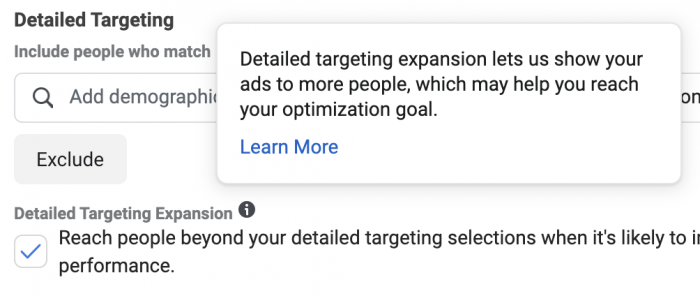
Eventually, it was renamed Advantage Detailed Targeting. It became the default and could no longer be turned off when optimizing for landing page views, link clicks, conversions, or conversion value. Advertisers lost control.

The same was the case for lookalike audience expansion. Advertisers initially had the option of turning this on, which would allow Meta to expand your lookalike audience if it would improve results.
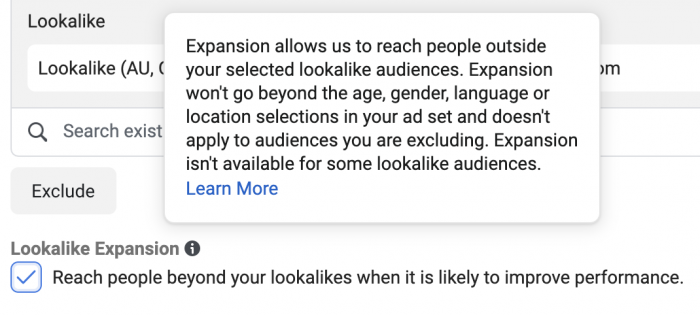
This feature would be renamed Advantage Lookalike, and it couldn’t be turned off when optimizing for conversions or conversion value.
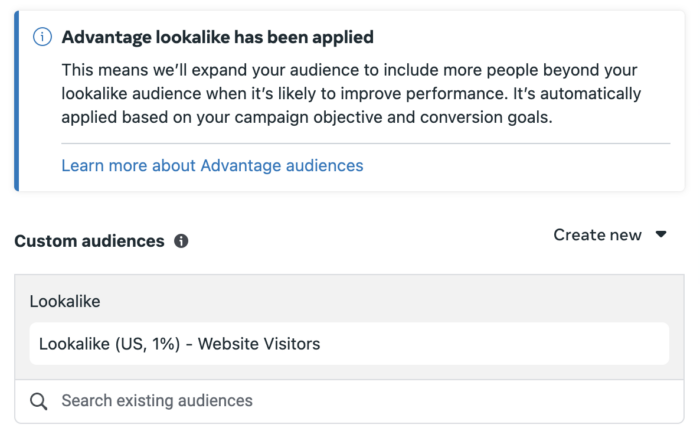
Along the way, Meta introduced Advantage+ Audience. When used, targeting inputs including age maximum, gender, custom audiences, lookalike audiences, and detailed targeting would all be viewed as suggestions. Meta could (and would) reach people beyond these inputs if it would improve results.
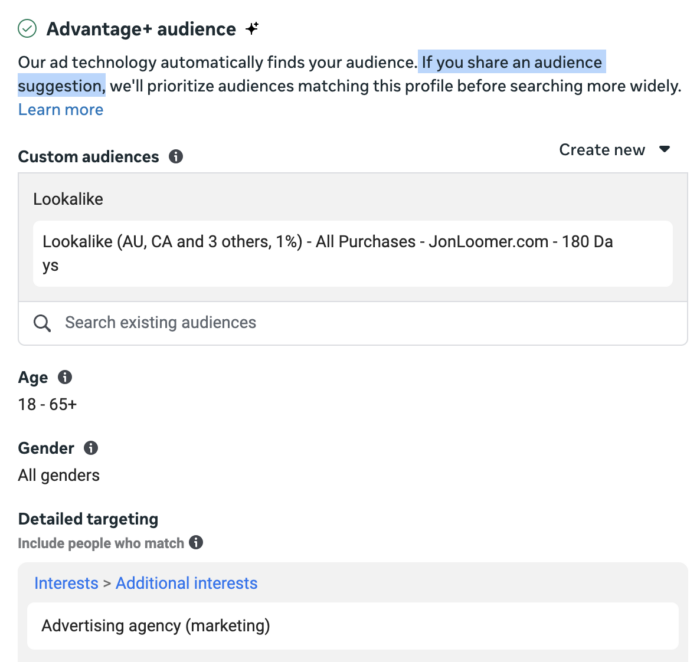
Meta made Advantage+ Audience the default. You could “switch” to original audiences, but it was strongly discouraged.
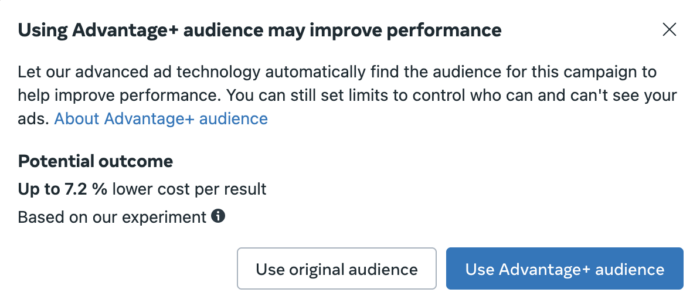
But this ability to “switch” was part of the problem. Advertisers thought it gave them back more control than it did. But switching didn’t actually give you more control over detailed targeting or lookalike audiences when using performance goals that would automatically initiate expansion. In most cases, advertisers didn’t know this.
It didn’t matter whether you used Advantage+ Audience or original audiences when it came to control over detailed targeting and lookalike audiences in certain situations. The wording changed, but the expansion still happened. It was a mirage of control.
That mirage is disappearing with the move to the new Advantage+ Campaign setup. The language has changed. Advantage Detailed Targeting and Advantage Lookalike have disappeared. Now, the fact that these inputs are merely “suggestions” in many cases is no longer avoidable.

If you’re optimizing for any type of conversion, your targeting control is limited. During the past couple of years, you thought you had more control than you did. That mirage is gone.
Because control over targeting is limited, stop obsessing over your interests, behaviors, and lookalike audiences. It’s debatable whether these inputs make any difference at all. They aren’t respected. The algorithm is going to go where it needs to go to get results.
If you’re advertising like it’s 2017, you may actually be making your results worse. There’s no reason to create separate ad sets for lookalike audiences, detailed targeting, and broad. You’ll get different results, but those results are likely built on randomness. And you’re able to reach all of the same people in each ad set.
Let go of the targeting control you once had, thought you had, but no longer do.
“I Need to Find a Winner”
Do you though?
Let me pose this controversial question for advertisers. It’s been so baked into our roles and responsibilities that it’s assumed to be necessary and advantageous.
Do you actually need to find a winning combination of ad copy and creative?
Abandoning this thinking may sound crazy, but we could say the same for the evolution of how we approach targeting. We should ask whether our approach to ad copy and creative remains relevant.
Don’t misconstrue what I’m suggesting here. Your ad copy is important. Your creative choices are important. You want to generate combinations that result in conversions. But I contend that you rarely need to find the winning version now.
Let’s go back to 2017 as our “good old days” point in time. We had far fewer placements. Each ad had a single primary text, headline, description, and either image or video. “Finding a winner” was not only possible, but a worthy goal.
Think about how things have changed in this area. By my count, there are 26 placements, and new ones keep emerging. Advertisers are encouraged to provide up to five versions of primary text, headline, and description for each ad. Meta can show a different version of your ad and combination of assets, depending on the placement and person that is reached.
Put aside whether finding a winning combination is necessary for a moment. Is it possible? For most advertisers with modest budgets, I’d argue that the volume of results for a single combination is negligible. That data is often too watered down to be meaningful.
But the other question is whether finding that winner is beneficial. Let’s say you managed to isolate the highest performing combination of primary text, headline, description, and creative. This is the highest performing combination across all placements, shown to all people.
This ignores some important facts about how delivery optimization works. That combination worked best overall, but it doesn’t mean that other versions weren’t the best for a specific person or placement. One reason why that “best combination” worked so well is that a different combination was shown when that combination would be less effective.
Every person is different. Every placement is different. It’s quite likely, if not probable, that the best performing combination of assets will be different for Facebook Mobile Feed than it is for Instagram Reels. Interaction with content in those placements is different, so why wouldn’t the best performing ad be different?
Finding a winning combination attempts to simplify a complex problem. And that complex problem doesn’t always need a solution.
The algorithm isn’t perfect. But human interpretation of results is often even less reliable. See my post about Breakdown Effect to learn more about how we often misinterpret the meaning of results when it appears to us that budget is incorrectly spent on a lower-performing ad creative.
“I Turn Off Low-Performing Placements”
I feel we’re finally getting to the place where most advertisers understand that turning off low-performing placements is rarely a good approach. But this outlook doesn’t yet have full adoption.
It seems counter-intuitive. You break down your results by placement and see that one is generating a low volume of conversions — or the highest Cost Per Conversion. It’s only logical to assume that if you turn it off that your results will improve.
So you turn it off. But you don’t see that improvement. Why?
Some placements are more likely to get noticed than others. Some are more likely to get a click. But simply because a placement doesn’t get credit for a conversion doesn’t mean that it wasn’t helpful.
Consider the Right Column as an example. This placement is rarely clicked. But it’s also very visible and cheap. While a high impression frequency in the feed may be annoying and expensive, a high frequency in the right column is likely to be neither. But it can influence the eventual decision.
To put it simply, if you force only the top two “most effective” placements and remove everything else, you’re unlikely to get better results. Your costs will skyrocket.
There’s a certain level of trust that you need to have that the algorithm will perform as it’s intended. But as long as you don’t waste a high-percentage of your budget on a low-performing placement (normally found with top-of-funnel optimization), stick with all placements.
This is not control that you need. It is inefficient. Keep your hands off.
“I Turn Off Every Enhancement”
It’s long been popular to bash Meta’s Advantage+ Creative enhancements, and that popularity is sometimes earned. Some of these enhancements have been known to freak out clients when they contradict approved creative.
But AI-driven enhancements are getting better. Adding animation to static images to make them stand out. Generating backgrounds to fill in blank spaces by placement. Making automatic adjustments by placement or adjusting aspect ratios for a better fit. Highlighting important text to inspire action.
Do not take a blanket approach to these enhancements in the name of greater control. Review them in the Advanced Preview to get a sense of how they work, but many of them are low-risk and worth keeping.
Even the most criticized enhancements can be salvaged. Most advertisers turn off Music due to the auto-generated selections Meta chooses. But these selections can be customized. The right musical complement is better than no sound when your image is shown in the Stories placement.
I’m not suggesting that you should blindly accept all enhancements. But the opposite may be worse. Know what you’re accepting and make customizations where necessary. Turn off the enhancements that can’t be saved.
Over time, these AI-powered enhancements will get better and more advantageous. Those who reactively reject them all will be carelessly hurting potential results in the name of control.
Embrace Dwindling Control
Those who cling to the little control we have and feel attacked by this post will miss the point. I’m not suggesting that there are never exceptions.
There are times when you may need to add back some targeting control to override weaknesses in the ad delivery algorithm. Meta is providing some help in this area with Value Rules.
There are times when you can spend enough and get the volume of results necessary to find a winning combination of creative assets to get something meaningful. In that case, there can be a benefit, and you can apply that information to potential changes.
There are times when Advantage+ Creative enhancements are not only unhelpful, but potentially harmful.
All of these things are true. Know the difference.
Accept that you have less control than before, and you’re not getting it back. Recognize that manual tweaks often do more harm than good.
Clinging to the past isn’t a badge of honor. Rejecting automation for the illusion of control won’t end well.
You’ll become obsolete.
If you are offended by this post or feel attacked by my words, I encourage you to step back. Think about where we are now and where Meta advertising is headed. And ask yourself: Do I want to be stuck in the past or be part of the future?
Change is often painful. I’ve experienced that firsthand. I, too, struggled to evolve and resisted change.
Eventually, I let go of the resistance and embraced change. You can, too.
Your Turn
What loss of control have you finally embraced regarding Meta advertising?
Let me know in the comments below!
The post The Illusion of Control in Meta Advertising appeared first on Jon Loomer Digital.
¿Te gustaría tener un "Empleado Digital" que trabaje por ti?
Este blog funciona en piloto automático gracias a la tecnología n8n. Aprende a montar tu propio imperio automatizado por menos de lo que cuesta una pizza.
🚀 Acceder al Curso (Oferta $10)🔒 Garantía de satisfacción de Hotmart
